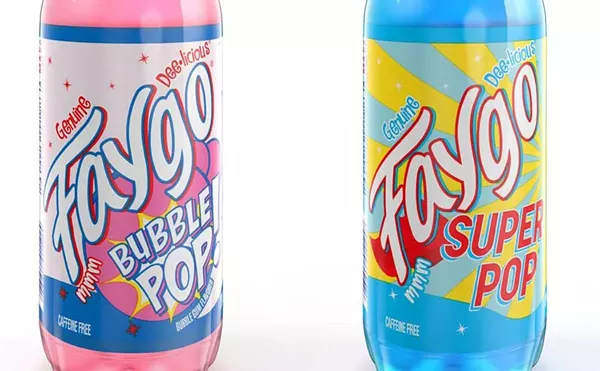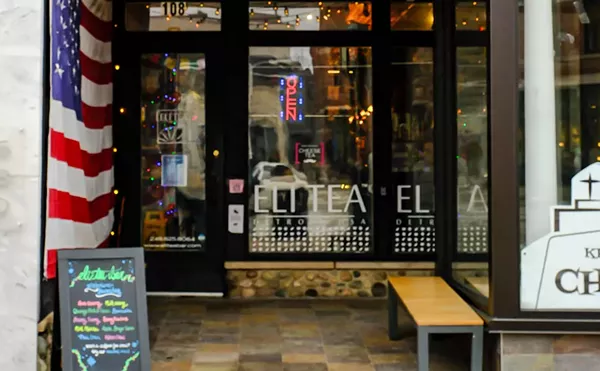Amani's
13823 Michigan Ave.
Dearborn
313-584-1890
Amani's is a halal neighborhood place, across from Dearborn City Hall, that serves all the tried-and-true dishes of Lebanese cuisine that Westerners tend to order — hummous, kebabs, tawook, shawarma — plus some that deserve to be more widely known. In particular, the chef does a great job with makaneck or sojouk.
It's advertised as a $10 appetizer, a big plate of two-inch sausages cooked in an oily and delicious sauce of tomatoes, parsley, garlic — and a few slices of pickle, which add a marvelous piquancy.
I called the Greenland Market (15237 W. Warren Ave., Dearborn; 313-945-5445; 6 a.m.-11 p.m. daily) to find out how they make their makaneck and sojouk. The meat department mentioned white vinegar, coriander and mustard mixed with beef and lamb, in a lamb intestine casing, but I suspect there's much more, and that every butcher's recipe is distinct. Different online sources mention pine nuts, cumin and cloves. Sojouk is the hotter version, made at Greenland in a plastic casing.
Amani's gets its sausage elsewhere, but the flavors are superbly complex and satisfying, which is due partly to the cooking method. Add a salad and pita and you have a meal.
There are always plenty of customers at Amani's, of both the east and west Dearborn persuasion, though it's not a fancy place. Pita is the triangles-in-a-baggie variety, not made in-house. Tables are bare, and the decor is a jumble of tiles, leaded glass, carved wooden screens, a picture of burnoose-clad men on camelback, and a few brass trappings. Friendly waitresses are well-informed, and it's a pleasure to hear them repeat your order; I thought the "r" in arayes would go on forever.
Baba ghanoush, to my mind, should be more popular than hummus, not less, but we Americans tend to go blander when possible. Both are standouts at Amani's, the hummus of the plainest — just a strong chickpea flavor, as velvety as it can possibly be. Baba is richer, garlicky and smoky, a delight.
Another great appetizer is fried kibbeh, which is fried twice for good measure. First raw lamb and cracked wheat are processed together to form the kibbeh shell. Then more lamb, onions and pine nuts are fried, to make the filling. Balls of kibbeh mixture are hollowed out and stuffed, formed into torpedoes and deep-fried. They don't look like much, unless you know how succulent the result is; the interior is as moist and tender as can be.
Falafel, made from ground chickpeas and fava beans and deep-fried, are also tasty, though a tad overdone on the night I ordered them. I think falafel work better when they're larger, so the ratio of green and spicy filling to crunchy crust is higher. There's a hint of cloves in Amani's version.
A party of four seeking meat would do well to order the Jumbo Platter, advertised for three. The servings of hummus, fattoush and baba ghanoush are large, and the charcoal-grilled skewers of kebab (beef), tawook (chicken) and kafta (ground beef pressed into shape with onions, tomato and parsley) are cooked with onions, peppers and carrots. The chicken in particular is a fine product of the griller's art, with a bit of mint flavor. The platter also includes a mound of yellow rice (from yellow pepper) and, my favorite, a heap of lamb shawarma. The snow-white garlic sauce is creamy, just sharp enough.
Lebanon has a seafood tradition, being on the Mediterranean, and shrimp and several fish are offered. We had a whole red snapper that was presented vertically rather than lying down on the plate. It looked as if it were swimming happily along, though thoroughly deep-fried. The white flesh was moist and full of flavor, but picking it out from among the many tiny bones was time-consuming. If there were classes to make a food-bolter decelerate and savor his meal, this red snapper could be part of the curriculum.
Breakfast is the time to try some traditional Lebanese dishes: foul (favas cooked with chickpeas, garlic, lemon and olive oil); eggs with makanek or sojouk; labneh, a thick yogurt, with olives; fateh. They're served till 2 p.m. but can be available later if supplies last. Fresh-squeezed juices are orange, apple and carrot, a bargain at $3.50 for 12 ounces.
For dessert, I can't recommend the rice pudding with pistachios and rosewater, which was more Jell-O-like than creamy. The deli case in front contains some alarmingly pink custards. Cr�me caramel, though, was rich and fine, a byproduct of the French occupation of Lebanon between the two world wars, thus proving the law of unintended consequences. (Whatever their imperial sins, the French have left culinary footprints in many places, from Vietnam to Tunisia.)
But you'll be going for the truly Lebanese food. If you're in a rut, get out of it and try some little sausages.








